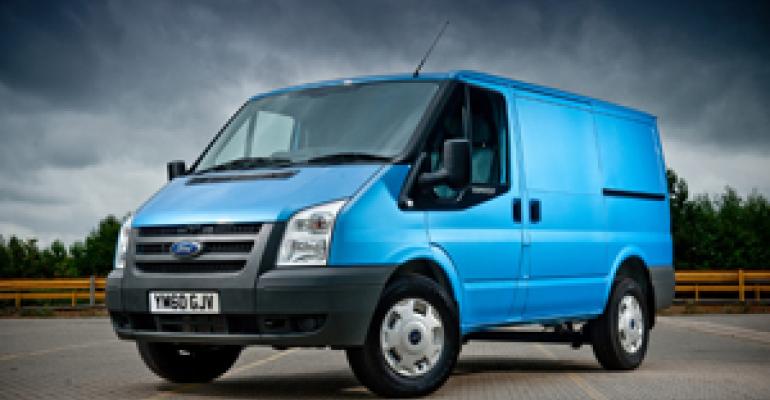
Ford confirms the future of its global commercial-van lineup rests on a single platform.
In a presentation webcast today from the UBS Frankfurt Auto Show Investor Conference in Germany, Ford Chief Financial Officer Lewis Booth outlines the auto maker’s efforts to improve scale, a key element of its growth strategy.
One presentation slide about platform consolidation shows the Ford Transit converging with the Ford E-Series van. Currently, the Transit and E-Series are on different platforms.
Ford had been mum on its commercial-van strategy. Speculation has centered on likelihood that the Transit, sold in numerous markets, would replace the E-Series, which is exclusive to North America.
In his presentation, Booth mentions only “the Transit” when referring to the platform that will support Ford’s commercial-van aspirations. Contacted by WardsAuto, the auto maker declines further comment.
Booth’s presentation does not address timing, but Ford last year invested $630 million to prepare for next-generation Transit production at its plant in Kocaeli, Turkey. The auto maker also has an agreement with the United Auto Workers union that proposes a new product for Ford’s Avon Lake, OH, plant in 2014.
Avon Lake is home to the E-Series, which last year marked its 50th anniversary on the market and dominates North America’s fullsize van segment. Cementing its supremacy, the E-Series’ share of U.S. van sales has risen 11.1 points since 2001 to 56.8% through August, according to WardsAuto data.
The Transit has a similar record in Europe. Since its launch in 1965, it has been at or near top of the best-sellers in its competitive set.

Against this backdrop, there is global frenzy on the light-commercial-vehicle scene. Among the developments:
- Europe this year passes new fuel-economy rules mandating a 27.6% reduction in average LCV carbon-dioxide emissions by 2020.
- The Renault-Daimler partnership will produce a Mercedes-Benz version of the Renault Kangoo next year, while Renault will provide the engine and transmission for the German brand’s Vito van.
- Chrysler’s Ram brand prepares to introduce the first of up to three Fiat-designed commercial vans – two large, one small – in the U.S., where large-van sales through August are tracking 17.4% ahead of like-2010.
The recent North American launch of the Nissan NV LCV and the breakneck U.S. sales pace of the Mercedes Sprinter – which is on track to double its 2010 delivery total – are further evidence that the boxy, upright van styling arguably popularized by the Transit has become the global standard.
“Clearly, customer tastes have converged,” Booth says, adding this trend meshes neatly with Ford’s platform-consolidation strategy.
![<link rel="stylesheet" href="http://subscribers.wardsauto.com/galleries/files/lightbox.css" type="text/css" media="screen" />
<script src="http://subscribers.wardsauto.com/galleries/files/prototype.js" type="text/javascript"></script>
<script src="http://subscribers.wardsauto.com/galleries/files/scriptaculous.js?load=effects" type="text/javascript"></script>
<script src="http://subscribers.wardsauto.com/galleries/files/lightbox.js" type="text/javascript"></script>
<p><a href="http://subscribers.wardsauto.com/galleries/2011/fordchart-gallery.jpg " rel="lightbox[plants]" title=" Ford platform consolidation plan.">View Larger</a></p>
<a href="http://subscribers.wardsauto.com/galleries/2011/fordchart-gallery.jpg" rel="lightbox[plants]" title=" Ford platform consolidation plan."></a>](http://subscribers.wardsauto.com/images/2011/09/ford-chart.jpg)
The auto maker has set its global wholesale-volume sights on 8 million units by mid-decade. And two platforms , a B- and C-segment, will account for 6 million.
“The way to grow profitably is not just to grow volumes, but to improve our scale,” Booth says, adding the C-segment platform will accommodate some 10 variations, ranging from the fully electric Focus EV to a cross/utility vehicle designed to replace the Ford Escape and Ford Kuga.
Homogenizing Ford’s lineup also leverages the proliferation of product information available to consumers.
Says Booth: “We’ve also seen as customers become much more Internet-savvy. They know what’s for sale around the world. Many of them were asking, ‘Why can’t we have the (European-market) cars in North America?’
“We’ve answered those questions by absolutely not dumbing (product) down,” he adds. “There’s no point in launching a compromised product, because a compromised product doesn’t get you (acceptable) transaction prices.”
However, Booth assures that allowances will be made to satisfy regional consumer preferences. As an example, he notes the wagon derivative of the newly launched global Focus is not available in North America.
“That’s really a European-market preference only,” he says. As are diesel engines, he adds.
“Those are the things that generate some of the lack of commonality.”




